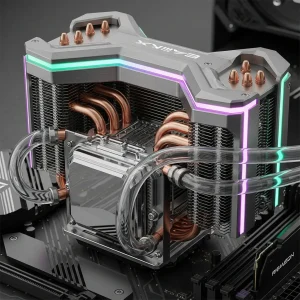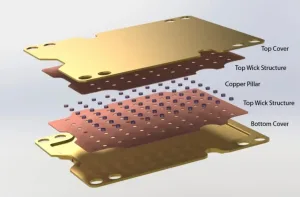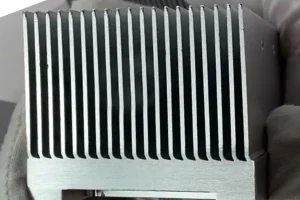Understanding Heat Sinks: Essential Cooling Solutions
Introduction to Heat Sinks:
Vital Components in Electronics for Thermal Management
Heat sinks are vital components in the world of electronics, playing a crucial role in maintaining optimal performance and longevity of devices. They are designed to dissipate excess heat from electronic components, ensuring that systems do not overheat and malfunction. In this article, we will explore various types of heat sinks, their applications, and the importance of choosing the right cooling solution for your needs.
What is a Heat Sink?
Understanding Its Function and Importance in Electronics
A heat sink is a passive heat exchanger that transfers heat generated by an electronic or mechanical device to a fluid medium, often air or liquid. This process helps to lower the temperature of the device, preventing overheating. Heat sinks are commonly found in computers, LED lighting, and various other electronic devices.
How Heat Sinks Work
Increasing Surface Area for Efficient Heat Dissipation
The primary function of a heat sink is to increase the surface area available for heat dissipation. By doing so, it enables more efficient heat transfer from the device to the surrounding environment. Heat sinks typically consist of a base and fins, with the base absorbing heat from the device and the fins increasing the surface area for heat dissipation.
Heat Sink Base Materials
Copper and Aluminum for Maximum Heat Absorption
The base of the heat sink is often made of materials with high thermal conductivity, such as copper or aluminum, to effectively absorb heat from the device. This base is designed to be in direct contact with the heat-producing component, ensuring maximum heat absorption.
The Role of Fins in Heat Dissipation:
Maximizing Surface Area for Effective Cooling
Once the heat is absorbed by the base, it is transferred to the fins. The fins, with their increased surface area, allow for efficient dissipation of heat into the surrounding air or fluid. This process is crucial for maintaining the device’s temperature within safe limits.
Convection and Heat Dissipation:
Air vs Liquid Cooling Systems Explained
Convection plays a significant role in the heat dissipation process. In air-cooled systems, natural convection occurs as air moves over the fins, carrying away heat. In liquid-cooled systems, forced convection is used, where a liquid medium circulates through the system to remove heat.
Air-Cooled Heat Sinks:
Popular Designs and Solutions for Electronics Cooling
Air-cooled heat sinks are the most common type used in consumer electronics. They rely on natural or forced air convection to dissipate heat. Common air-cooled heat sink designs include:
Skived Heat Sink: Made by cutting fins from a solid block of metal, skived heat sinks offer excellent thermal performance and are often used in high-power applications.
Custom Copper Heat Sink: Known for their superior thermal conductivity, copper heat sinks are ideal for applications requiring efficient heat dissipation.
Large Aluminum Heat Sink: Aluminum heat sinks are lightweight and cost-effective, making them suitable for a wide range of applications.
Skived Heat Sinks
High-Efficiency Cooling for Power-Intensive Applications
Skiving involves a precise cutting process where fins are sliced from a solid block of metal, typically copper or aluminum. This method allows for the creation of thin, closely spaced fins, enhancing the heat sink’s surface area. Skived heat sinks are highly efficient, making them suitable for high-power applications where thermal management is critical.
Custom Copper Heat Sinks
Tailored Solutions for Maximum Heat Transfer Efficiency
Copper is renowned for its exceptional thermal conductivity, making it a preferred choice for custom heat sinks. These heat sinks are often tailored to specific applications, ensuring optimal performance. The customization process involves designing the heat sink to meet unique size, shape, and thermal requirements, which can significantly enhance cooling efficiency.
Aluminum Heat Sinks
Lightweight and Cost-Effective Solutions for Cooling Electronics
Aluminum is favored for its lightweight and cost-effective properties, making it ideal for large-scale production. Large aluminum heat sinks are commonly used in applications where weight is a concern, such as portable electronics. Despite being less thermally conductive than copper, aluminum’s advantages in cost and weight make it a popular choice for many applications.
Liquid-Cooled Heat Sinks
Advanced Cooling Solutions for High-Performance Systems
Liquid-cooled heat sinks use a liquid medium, such as water, to transfer heat away from electronic components. This type of cooling is more efficient than air cooling and is commonly used in high-performance systems. Key liquid-cooled heat sink designs include:
Liquid Cold Plate: These devices use a cold plate in contact with the heat source, with liquid flowing through channels to carry heat away.
Water Cooling Plate: Similar to liquid cold plates, water cooling plates use water as the primary cooling medium for effective heat dissipation.
Liquid Cold Plates
Efficient Heat Transfer for Heavy Workloads and High Heat Flux
Liquid cold plates are designed to provide direct contact with the heat source, maximizing heat transfer. Channels within the plate allow the cooling liquid to flow across the heated surface, absorbing and carrying away heat. This method is highly effective in maintaining low temperatures for components under heavy workloads.
Water Cooling Plates
Superior Heat Dissipation for Quiet and Efficient Cooling
Water cooling plates function similarly to liquid cold plates but specifically use water as the cooling medium. Water’s high specific heat capacity makes it an excellent choice for absorbing large amounts of heat. These plates are commonly used in systems requiring quiet operation and high cooling efficiency, such as gaming PCs and servers.
Air-Cooled vs Liquid-Cooled Heat Sinks:
Comparing Performance and Costs
When comparing liquid-cooled and air-cooled systems, liquid cooling offers superior heat removal capabilities, especially in high-power applications. However, it often involves more complex setups and higher costs. Air cooling, while less efficient, is simpler, more cost-effective, and sufficient for many consumer electronics.
Advanced Cooling Solutions
Heat Pipes, Vapor Chambers, and Custom GPU Heat Sinks
Advanced cooling solutions combine various technologies to provide superior thermal management. Some popular options include:
Heat Pipe Heat Sink: Heat pipes are sealed tubes containing a liquid that evaporates and condenses to transfer heat efficiently. They are often integrated into heat sinks to enhance performance.
Vapor Chamber Cooling: This technology uses a vapor chamber to spread heat evenly across the heat sink surface, improving thermal performance in high-power applications.
Custom GPU Heat Sink: These heat sinks are specifically designed for graphics processing units (GPUs) to ensure optimal performance in gaming and professional applications.
Heat Pipes in Heat Sinks
Efficient Thermal Conductors for Enhanced Cooling
Heat pipes are highly efficient thermal conductors. They consist of a sealed tube filled with a working fluid that undergoes phase changes to transfer heat. When integrated into heat sinks, they enhance the heat transfer process, making them ideal for applications requiring quick and efficient cooling.
Vapor Chamber Cooling
Even Heat Distribution for High-Performance Electronics
Vapor chambers function similarly to heat pipes but offer a more planar design, allowing for even heat distribution across the surface. This technology is particularly beneficial in applications with high heat flux, such as high-performance CPUs and GPUs, where maintaining uniform temperature distribution is crucial.
Custom GPU Heat Sinks
Tailored Cooling for Gaming and Professional Systems
GPUs generate significant heat, especially during intensive tasks like gaming and rendering. Custom GPU heat sinks are designed to handle these thermal loads, often incorporating advanced technologies like vapor chambers and heat pipes. These custom solutions ensure GPUs operate efficiently, preventing throttling and maintaining performance.
How to Select the Right Heat Sink for Your Application
Selecting the appropriate heat sink for your application involves considering several factors, such as thermal performance, cost, and size constraints. Here are some tips to help you make the right choice:
Understanding Thermal Performance
Key Factors for Heat Sink Selection
Determine the amount of heat your device generates and the maximum temperature it can withstand. This information will help you select a heat sink with the appropriate thermal performance.
How to Calculate Heat Dissipation Needs for Your System
Start by reviewing the specifications of your electronic device to understand its thermal output. Most manufacturers provide information on the maximum thermal design power (TDP) or heat output, which serves as a guideline for selecting a suitable heat sink.
Balancing Performance and Cost
Choosing a Heat Sink Within Your Budget
Once you know the TDP, calculate the heat dissipation needs of your system. Consider factors such as ambient temperature, airflow, and device usage. This calculation will guide you in choosing a heat sink that can maintain safe operating temperatures under all conditions.
Choosing the Right Heat Sink Material
Copper vs Aluminum for Efficiency and Cost
While high-performance heat sinks offer excellent cooling, they often come at a higher cost. Evaluate your budget and performance requirements to find a balance that meets your needs without overspending. Consider whether advanced cooling technologies are necessary for your application.
Heat Sink Design Options
Skived, Extruded, and Stamped Designs Explained
Choose a heat sink material and design that best suits your application. Copper and aluminum are popular choices due to their thermal conductivity and cost-effectiveness. Skived, extruded, and stamped designs offer varying levels of performance and cost.
Copper vs Aluminum Heat Sinks:
Which Material is Right for Your Needs?
Copper’s high thermal conductivity makes it an excellent choice for applications requiring efficient heat transfer. However, it is heavier and more expensive than aluminum. Aluminum, while slightly less efficient thermally, is lightweight and cost-effective, making it suitable for many consumer applications.
Choosing the Right Heat Sink Design
Skived, Extruded, or Stamped for Your Needs
Heat sink design plays a critical role in its performance. Skived designs offer high efficiency with closely packed fins, while extruded designs are suitable for mass production. Stamped designs are cost-effective but may offer lower thermal performance, making them ideal for less demanding applications.
Standard vs Custom Heat Sink Designs
Which is Right for Your Application?
Standard heat sink designs are readily available and cost-effective, suitable for general applications. However, custom designs tailored to specific applications can significantly enhance performance. Consider working with manufacturers to develop a custom solution if standard options do not meet your requirements.
Consider Size and Weight Constraints When Choosing a Heat Sink
Ensure the heat sink you choose fits within the size and weight limitations of your device. Large aluminum heat sinks may provide excellent cooling, but they might not be suitable for compact or portable devices.



